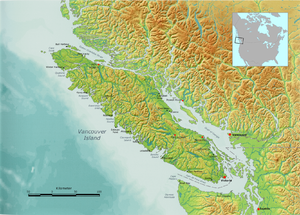Juan de Fuca street
| Juan de Fuca Street / Strait of Juan de Fuca | |
|---|---|
| Juan de Fuca Strait with the Olympic Mountains in the background from Port Angeles | |
| Connects waters | Pacific Ocean |
| with water | Puget Sound , Strait of Georgia |
| Separates land mass | Olympic Peninsula |
| of land mass | Vancouver Island |
| Data | |
| Geographical location | 48 ° 18 ′ N , 124 ° 3 ′ W |
| length | 150 km |
| Smallest width | 20 km |
The Juan de Fuca Strait ( English Strait of Juan de Fuca ) is a strait on the west coast of North America.
The inlet of the Pacific Ocean protrudes about 150 kilometers inland between Vancouver Island ( British Columbia ) and the Olympic Peninsula ( Washington ) before it merges northward into the Strait of Georgia and southward into Puget Sound . The strait is about 20 to 25 kilometers wide; at its eastern end it spreads for more than 40 kilometers.
The Juan de Fuca Strait is a manageable waterway from the Pacific estuary over a length of around 150 kilometers, in the middle of which the state border of the United States and Canada runs. Then the water goes into a wide bay with many small islands and other waterways.
The largest islands at the end of Juan de Fuca Strait are Whidbey , Orcas , Fidalgo , Lopez, and San Juan . The most important cities in the inlet are Victoria in the Canadian province of British Columbia and Port Angeles in the US state of Washington . An international ferry runs between the two cities .
Juan de Fuca Street is named after the Greek navigator Juan de Fuca (actually Ioannis Phokas), who sailed past here in 1592 to look for the Anian Strait ( Northwest Passage ) for Spain , which did not exist.
The waterside border is part of a territorial dispute between Canada and the United States of America .
It is now known that the region was repeatedly hit by severe tsunamis. The earthquakes for the period around 1700, 1310, 810 AD and 170 and 780 BC have been identified through excavations and dendrochronological investigations. Prove.
See also
Web links
- Juan de Fuca Strait . In: BC Geographical Names (English)
- Juan de Fuca Strait ( English, French ) In: The Canadian Encyclopedia .
Individual evidence
- ^ Andrew Scott: The Encyclopedia of Raincoast Place Names: A Complete Reference to Coastal British Columbia . Harbor Publishing, Madeira Park, BC 2009, ISBN 978-1-55017-484-7 (English).
- ↑ Malaspina University College: The 1700 Juan de Fuca Earthquake by Steven Earle . Accessed March 6, 2013.

